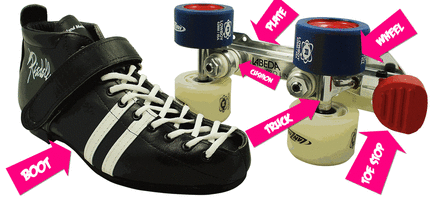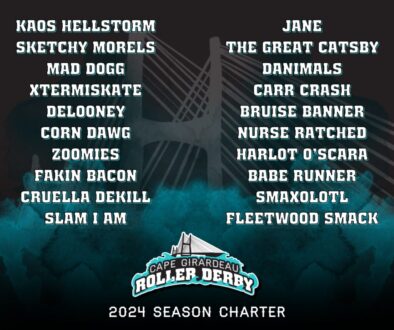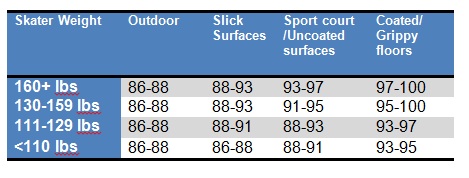Choosing the Perfect Skates: A Beginner’s Guide for Any Budget
So you’ve joined a Fresh Meat training program to learn how to play roller derby! Congratulations! There is SO MUCH to take away from the Fresh Meat training program: Rules of the game, history of the sport, how your team functions, new physical skills, etc. But one of the biggest questions a new skater has is, “How do I select new gear?” Over the next few blog posts, we’ll be discussing tips for selecting all types of gear; but today we’ll start from the bottom: How to Choose Skates for Roller Derby!
Let’s start with the basics…
- In roller derby, we skate on quad skates. No inlines here (unless maybe you’re a ref!)
- Derby skaters use low-cut skate boots. This provides more freedom of movement, more power, and less rubbing at the ankles.
- In this article we’ll be talking about boots (what you put your foot into) and plates. Plates attach the boots to the wheels and have a spot for the toe stop. The higher quality the plate, the better maneuverability and agility you’ll have. We’ll talk about wheels and toe stops later. See the graphic below to check out the parts of a skate.
- Derby skates are typically sold in men’s sizes, and fit is extremely important! Most speed skates are meant to fit a little tighter than your shoes, but they should still be comfortable.

When it comes to selecting skates, there is no single answer about which are best suited for a specific skater and situation. Selecting new skates depends on various factors: Level of commitment, budget, size of the skater, purpose of the skates, etc. A brand new skater who just wants his/her own gear to get through Fresh Meat may start with an entry level skate package. A skater who knows they are in it for the long haul may decide to invest in a higher quality skate up front. Consider your skill level and price point, then read on to get an idea of what skate set up is right for you!
“Beginning Skater, Nonexistent Price Point”
We’ve all been there. Maybe you REALLY want to play derby, but the funds are just not there right now. Don’t give up, there may still be options! At CGRD, we carry a small selection of loaner gear to help give new skaters time to save up funds for their own. Check with your league to see if this is an option. Other low cost options include borrowing from a friend/skater (yes, we often have multiple sets of skates!) or buying used off a Facebook group or EBay. Popular Facebook groups for gear include:
▪ Second Chance Skates where Skate Swag gets New life
▪ Roller Derby Swap Shop
▪ Derby Deals
▪ Roller Derby Recyclables
“Beginning Skater, Low Price Point”
Many skaters start roller derby with an entry level skate such as the Riedell R3, Riedell Dart, or Suregrip GT-50. You can expect to pay around $100-$130 for one of these basic skate set ups. The boot is usually made of synthetic material and come stock with a nylon plate and lower quality, slippery wheels. Most skaters would recommend you upgrade your wheels. Entry level derby wheels will cost you around $60 and include wheels such as the Radar Flat Outrageous, Riedell Radar Villains, and Suregrip Sugars. Some skate shops offer skate packages with upgraded wheels as a money-saving option.
“Intermediate Price Point”
For those skaters looking to upgrade or start out with a higher quality skate, you’ll want to start looking to upgrade the boot! Leather is more light weight and conforms to the foot over time, though they may need some breaking in. Riedell Vixens (165 leather boot) run around $250 with nylon plates and basic wheels. Skaters that weigh more than 200# should look for skate packages that contains an aluminum plate. Aluminum plates are more durable and responsive than nylon plates, though they are also heavier. Heavier aluminum plates under $100 include the Suregrip Competitor and Powerdyne Triton. Lighter, more expensive options include the Powerdyne Rival.
“High Price Point”
Over time, many skaters upgrade to a higher quality leather boot such as the Riedell 126 (around $230) or the ever-popular Riedell 265 (retail around $270). Most skaters also upgrade their plates for better maneuverability and less weight. The Powerdyne Revenge plate is made of extruded aluminum and is about 50% lighter than cast aluminum (such as the Powerdyne Triton). Sure Grip makes a popular magnesium plate (Sure Grip Avenger) which is 25% lighter than their aluminum version. These higher quality plates will run around $200 but provide better responsiveness and agility for more serious derby skaters.
“Price is no object!”
Aren’t you lucky!? Without money as a factor, you can consider a wide range of high end boots with customizable features such as Bonts, Antiks, and Riedell (195, 1065, etc). These boots are made with high quality materials, are often heat moldable, are light weight, and may be available in various colors! High end plates include Sure Grip Avengers, Powerdyne Arius, Roll Line, etc. Expect to pay $500+ with skates like these!
In summary, no one skate is perfect for all situations. Basic skates usually are made of synthetic material and come with nylon plates. Those serious about getting the most out of their skates typically upgrade to a leather boot and higher quality plates. Aluminum plates are stronger and more durable than nylon, though they are also heavier. Higher quality aluminum or magnesium plates offer better maneuverability without the weight. What skates are you interested in?
Need gear? Have questions? Check out skate packages and get advice from real derby skaters at Chico’s Skate Shop!



